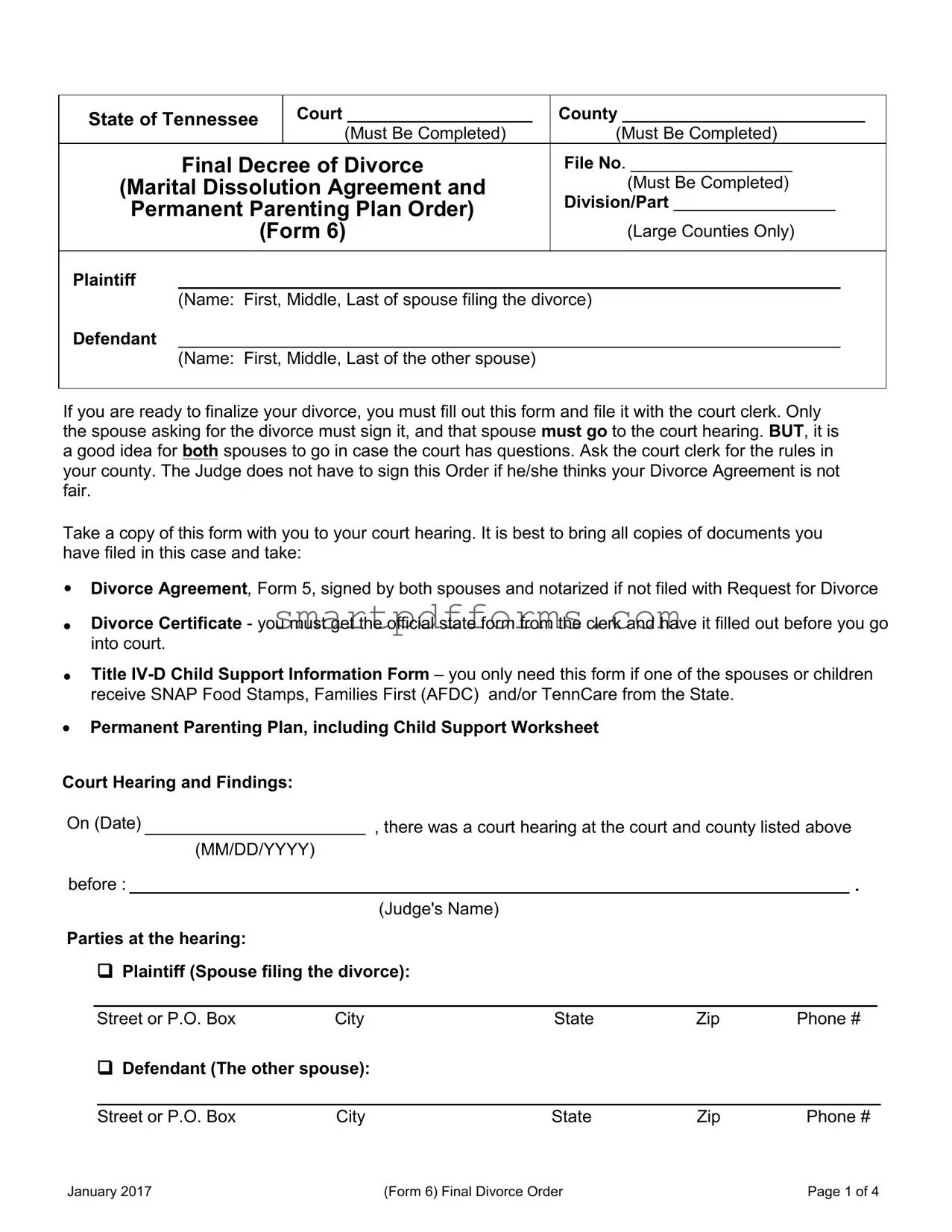
State of Tennessee |
Court |
|
County |
|
|
|
|
|
|
(Must Be Completed) |
(Must Be Completed) |
|
Final Decree of Divorce |
File No. _________________ |
(Marital Dissolution Agreement and |
(Must Be Completed) |
Permanent Parenting Plan Order) |
Division/Part _________________ |
(Form 6) |
(Large Counties Only) |
Plaintiff
(Name: First, Middle, Last of spouse filing the divorce)
Defendant
(Name: First, Middle, Last of the other spouse)
If you are ready to finalize your divorce, you must fill out this form and file it with the court clerk. Only the spouse asking for the divorce must sign it, and that spouse must go to the court hearing. BUT, it is a good idea for both spouses to go in case the court has questions. Ask the court clerk for the rules in your county. The Judge does not have to sign this Order if he/she thinks your Divorce Agreement is not fair.
Take a copy of this form with you to your court hearing. It is best to bring all copies of documents you have filed in this case and take:
•Divorce Agreement, Form 5, signed by both spouses and notarized if not filed with Request for Divorce
•Divorce Certificate - you must get the official state form from the clerk and have it filled out before you go into court.
•Title IV-D Child Support Information Form – you only need this form if one of the spouses or children receive SNAP Food Stamps, Families First (AFDC) and/or TennCare from the State.
•Permanent Parenting Plan, including Child Support Worksheet
Court Hearing and Findings: |
|
|
On (Date) |
, there was a court hearing at the court and county listed above |
|
|
(MM/DD/YYYY) |
|
|
before : |
|
|
. |
|
|
|
(Judge's Name) |
Parties at the hearing: |
|
|
Plaintiff (Spouse filing the divorce):
Street or P.O. Box |
City |
State |
Zip |
Phone # |
Defendant (The other spouse):
Street or P.O. Box |
City |
State |
Zip |
Phone # |
January 2017 |
(Form 6) Final Divorce Order |
Page 1 of 4 |
cannot send messages to each other through other people.
The Court further orders that they cannot contact each other after the divorce is final. They also
The Court orders both parties not to hurt or threaten the other.
Neither party has a current restraining order or wants a restraining order.
Restraining Order (check one):
The Court affirmatively finds as follows:
The spouses have sworn and affirmed they have children together who are under 18, in high school or disabled and neither spouse is pregnant. Children together means children they had together before the marriage and all children born or adopted during their marriage.
The spouses have both signed under penalty of perjury a proposed permanent Parenting Plan that includes all children the parties have together.
The spouses have made adequate and sufficient provision for the custody and support of all of their children and the court finds the proposed permanent Parenting Plan, including the parenting schedule, is in the children's best interest.
The spouses have both signed under penalty of perjury a Divorce Agreement (Marital Dissolution Agreement). That Agreement has disclosed fully the spouses' assets and liabilities and the court finds it equitably settles any and all property rights between them.
Alimony
Neither spouse wants alimony OR
The (check one): Plaintiff Defendant agrees to pay (amount):
each Week Month Other
The alimony will end on (date): __________________________OR
The alimony will end when this happens: ___________________________________________
____________________________________________________________________________.
The spouses are now divorced based on irreconcilable differences and are restored to the rights and privileges of unmarried persons. The Permanent Parenting Plan and Divorce Agreement (Marital Dissolution Agreement) are now a part of this Final Decree of Divorce.
Orders of Protection (check one):
Neither party has a current Protective Order.
The Court ends the current Protective Order.
The Court continues the current Protective Order from this Court until (MM/DD/YYYY): _____________.
Attach a Copy of the Order of Protection. Write the Case Number here:______________________
The parties have an Order of Protection in a different court. This Final Divorce Order does not change that Order of Protection.
Attach a Copy of the Order of Protection. Write the Case Number here:______________________
January 2017 |
(Form 6) Final Divorce Order |
Page 2 of 4 |
Name Change (check one):
This Order does not change either party’s name.
This Order changes the Plaintiff’s name to:
First Name |
Middle Name |
Last Name |
This Order changes the Defendant’s name to:
First Name |
Middle Name |
Last Name |
Important! You need to change your name on your driver’s license or other records. You may need a certified copy of this Order to do that.
Lawyers’ fees (check one):
Neither side has a lawyer.
The Plaintiff will pay for his/her lawyer’s fees. The Defendant will pay for his/her lawyer’s fees.
Other (explain):
________________________________________________________________________________
Court Costs will be paid as follows (check one):
The Plaintiff and Defendant will each pay half of the court costs.
Plaintiff will pay all costs.
Defendant will pay all costs.
Other agreement: _________________________________________________.
Other Orders
Notice: The Final Decree does not necessarily affect the ability of a creditor to proceed against a party or a party's property, even though the party is not responsible under the terms of the decree for an account, any debt associated with an account or any debt. It may be in a party's best interest to cancel, close or freeze any jointly held accounts. T.C.A. §36-4-134.
What this means: This Order does not protect you against creditors. They may try to collect from you, even if your spouse is supposed to pay the debt. It may be best to cancel, close, or freeze any accounts you have together.
This Order is made on Date (MM/DD/YYYY): |
|
by: |
Judge’s signature
January 2017 |
(Form 6) Final Divorce Order |
Page 3 of 4 |

This Order is not final until 30 days after the Judge signs it. During those 30 days, you may have questions about remarrying or buying property. If so, talk to a lawyer.
Presented by: _______________________________________________________________
Person Getting the Order
Plaintiff’s Signature
Date (MM/DD/YYYY): |
Plaintiff’s Phone Number: |
|
|
|
|
|
|
Defendant’s Signature |
|
|
|
Date: (MM/DD/YYYY) |
|
Defendant’s Phone Number: |
|
|
|
|
|
|
If your spouse did not go to this hearing, you must mail him/her a copy of this signed Final Divorce Order. Then fill out the part below.
Certificate of Service:
I swear and affirm that a copy of the Final Divorce Order was given to my spouse. It was delivered in person or sent by first-class U.S. Mail to this address:
I did so on the __________ day of ____________________ 20_______.
Spouse who mails it signs here:
Street Address:
City, State, Zip
Phone number:
Attached:
Divorce Agreement – Marital Dissolution Agreement (if not already submitted)
Divorce Certificate (if not already submitted)
Parenting Plan including Child Support Worksheet (if not already submitted)
Title IV-D Form (if not already submitted)
Other:
January 2017 |
(Form 6) Final Divorce Order |
Page 4 of 4 |




